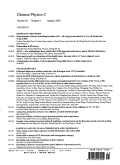- 钛学术文献服务平台 \
- 学术期刊 \
- 基础科学期刊 \
- 物理学期刊 \
- 中国物理C(英文版)期刊 \
Higgs decay to light(pseudo)scalars in the semi-constrained NMSSM
Higgs decay to light(pseudo)scalars in the semi-constrained NMSSM
基本信息来源于合作网站,原文需代理用户跳转至来源网站获取
摘要:
The next-to minimal supersymmetric standard model(NMSSM)with non-universal Higgs masses,i.e.,the semi-constrained NMSSM(scNMSSM),extends the minimal supersymmetric standard model(MSSM)by a singlet superfield and assumes universal conditions,except for the Higgs sector.It can not only maintain the simpli-city and grace of the fully constrained MSSM and NMSSM and relieve the tension they have been facing since the discovery of the 125-GeV Higgs boson but also allow for an exotic phenomenon wherein the Higgs decay into a pair of light(10~60 GeV)singlet-dominated(pseudo)scalars(hereafter,in this paper,we use"scalar"for both scalars and pseudoscalars,considering pseudoscalars can also be called CP-odd scalars).This condition can be classified in-to three scenarios according to the identitiesof the SM-like Higgs and the light scalar:(i)the light scalar is CP-odd,and the SM-like Higgs is h2;(ii)the light scalar is CP-odd,and the SM-like Higgs is hi;and(iii)the light scalar is CP-even,and the SM-like Higgs is h2.In this work,we compare the three scenarios,checking the interesting para-meter regions that lead to the scenarios,the mixing levels of the doublets and singlets,the tri-scalar coupling between the SM-like Higgs and a pair of light scalars,the branching ratio of Higgs decay to the light scalars,and sensitivities in the detection of the exotic decay at the HL-LHC and future lepton colliders such as CEPC,FCC-ee,and ILC.Finally,several interesting conclusions are drawn,which are useful for understanding the different delicate mechanisms of the exotic decay and designing colliders in future.

推荐文章
Landau-Ginzbrug-Higgs方程的新精确行波解
Landau-Ginzbrug-Higgs方程
G/G′展开法
其次平衡原理
精确行波解
Oil geochemistry derived from the Qinjiatun–Qikeshu oilfields: insight from light hydrocarbons
Light hydrocarbons
Crude oil
Lishu Fault Depression
Geochemistry characteristic
基于ZigBee Light Link的楼宇照明系统设计
智能照明
遥控器
无线网关
ZigBee Light Link
基于SEMI标准的集成电路制造装备控制系统设计
集成电路制造装备
控制系统
SEMI标准
内容分析
关键词云
关键词热度
相关文献总数
(/次)
(/年)
文献信息
| 篇名 | Higgs decay to light(pseudo)scalars in the semi-constrained NMSSM | ||
| 来源期刊 | 中国物理C(英文版) | 学科 | |
| 关键词 | |||
| 年,卷(期) | 2021,(2) | 所属期刊栏目 | PARTICLES AND FIELDS |
| 研究方向 | 页码范围 | 246-256 | |
| 页数 | 11页 | 分类号 | |
| 字数 | 语种 | 英文 | |
| DOI | 10.1088/1674-1137/abce4f | ||
五维指标
引文网络
引文网络
二级参考文献 (0)
共引文献 (0)
参考文献 (0)
节点文献
引证文献 (0)
同被引文献 (0)
二级引证文献 (0)
2021(0)
- 参考文献(0)
- 二级参考文献(0)
- 引证文献(0)
- 二级引证文献(0)
引文网络交叉学科
相关学者/机构
期刊影响力
中国物理C(英文版)
主办单位:
中国物理学会
中国科学院高能物理研究所
中国科学院近代物理研究所
出版周期:
月刊
ISSN:
1674-1137
CN:
11-5641/O4
开本:
出版地:
北京市玉泉路19号(乙)中国科学院高能物理研究所内 北京918信箱
邮发代号:
创刊时间:
语种:
eng
出版文献量(篇)
3629
总下载数(次)
0
总被引数(次)
2764
期刊文献
相关文献
推荐文献
- 期刊分类
- 期刊(年)
- 期刊(期)
- 期刊推荐
力学
化学
地球物理学
地质学
基础科学综合
大学学报
天文学
天文学、地球科学
数学
气象学
海洋学
物理学
生物学
生物科学
自然地理学和测绘学
自然科学总论
自然科学理论与方法
资源科学
非线性科学与系统科学
中国物理C(英文版)2022
中国物理C(英文版)2021
中国物理C(英文版)2020
中国物理C(英文版)2019
中国物理C(英文版)2018
中国物理C(英文版)2017
中国物理C(英文版)2016
中国物理C(英文版)2015
中国物理C(英文版)2014
中国物理C(英文版)2013
中国物理C(英文版)2012
中国物理C(英文版)2011
中国物理C(英文版)2010
中国物理C(英文版)2009
中国物理C(英文版)2008
中国物理C(英文版)2021年第9期
中国物理C(英文版)2021年第8期
中国物理C(英文版)2021年第7期
中国物理C(英文版)2021年第6期
中国物理C(英文版)2021年第5期
中国物理C(英文版)2021年第4期
中国物理C(英文版)2021年第3期
中国物理C(英文版)2021年第2期
中国物理C(英文版)2021年第12期
中国物理C(英文版)2021年第1期

 免费查重
免费查重










